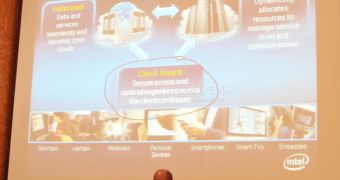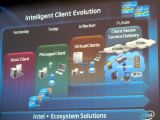As we've mentioned in a previous article, Intel's help in the establishment of the Open DataCenter Alliance was an important step in the company's Cloud 2015 vision, but it was by no means the only one, Intel having a lot more plans in store for the future, including here the development of device-savvy “client-aware” clouds.
According to Intel, these clouds actually know what types of applications, commands and processing should take place in the cloud or on your laptop, smartphone or other device, thus taking a user and specific device’s unique features into account to fully optimize an online experience.
During his keynote speech at Intel's event held at CERN, Geneva, Switzerland, Mr. Rick Echevarria, Vice President, Intel Architecture Group General Manager, Business Client Platform Division, had quite a few interesting things to say both about the company's vPro CPUs (a topic that we'll tackle more in-depth within a future article) and about these services as well.
The main idea here is that more and more “companion” devices, such as smartphones and Internet tablets, tend to make their way into the Typical “Business” Devices' category, some of them belonging to the users themselves, rather than the company they work for.
However, integrating all of these devices securely into the enterprise network can prove to be a bit difficult, making life a lot harder for the IT department, but also for the users themselves, since the services provided via the enterprise network are typically designed for a single “common denominator” platform, rather than several different ones.
This is in fact where these “Intel Web APIs” come into play, since they allow a certain service to accurately identify the specific platform the user employs, and then adapt the overall experience provided by the respective service to the end-point device's overall capabilities.
In fact, Intel had such a system setup for this event, which we've tested live, thus managing to see in real life just how the experience delivered by certain services to a computer running on an Intel Core i5 CPU can differ from the one delivered to a netbook powered by an Intel Atom CPU (and you can trust us that it really does differ, the one delivered to the more powerful computer being significantly richer than the one delivered to the Atom netbook).
Of course, it will be some time before these APIs get widely implemented, but, then again, cloud computing is quite far from having reached maturity, at least for the time being.

 14 DAY TRIAL //
14 DAY TRIAL // 

